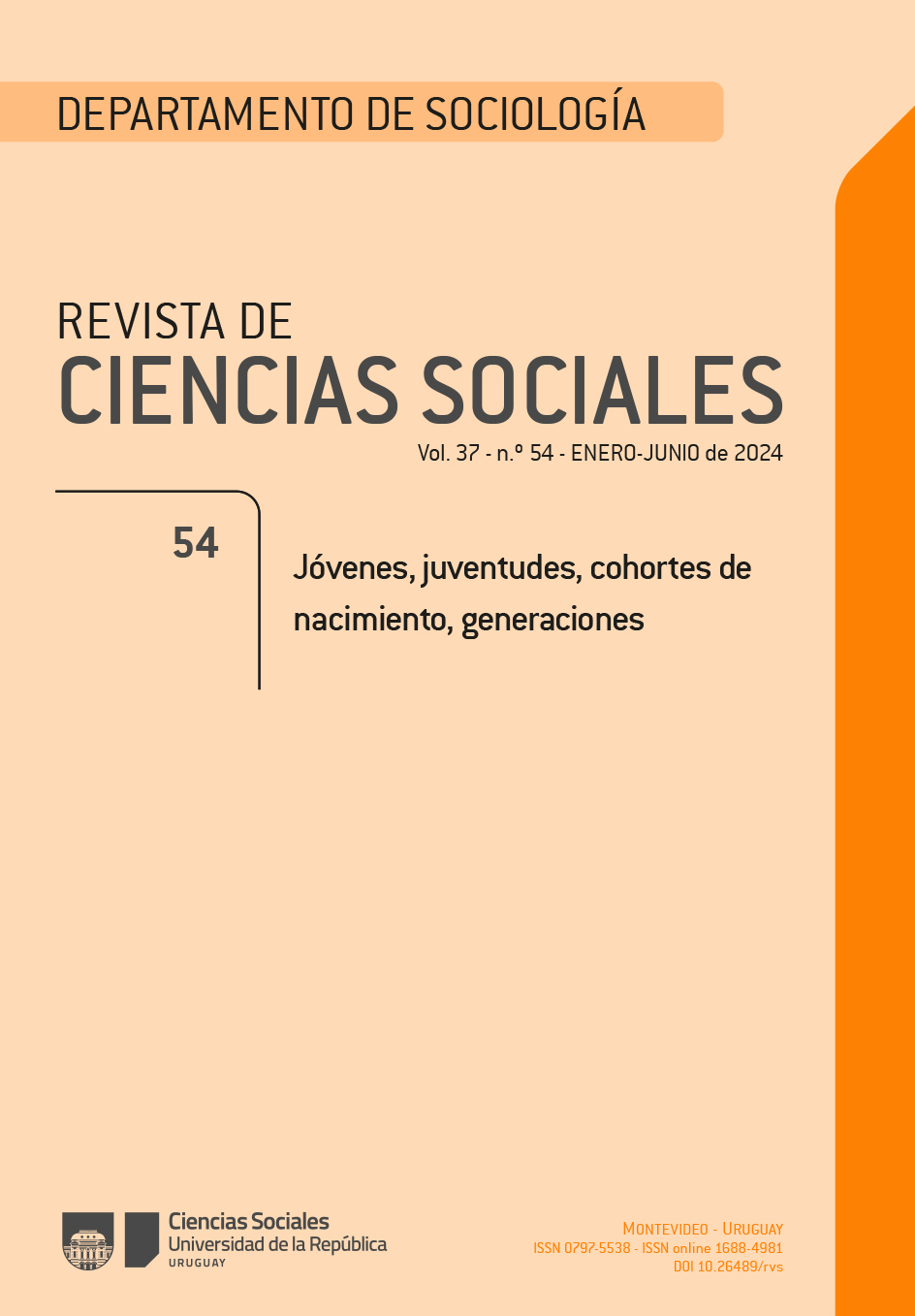Unemployment in Montevideo (1985-2019).
Analysis of age, period and cohorts
DOI:
https://doi.org/10.26489/rvs.v37i54.6Keywords:
histéresis, efecto cicatriz, tiempoAbstract
Youth unemployment is one of the keys in youth studies. One of the premises that is usually considered given (unquestioned and unquestionable) is that young people suffer from unemployment to a greater extent than adults. However, we can ask ourselves, has it always been the same? Does it affect some birth cohorts more than others? Does it vary in different historical periods? Even going further, if for different cohorts the effects on youth unemployment as a result of their structural positions (intra-cohort) are invariant over time. This article aims to answer these questions using a long series in time (1985-2019) of Continuous Household Surveys in Uruguay, using the Age-Cohort-Period Detrended (ACPD) technique. The tool allows distinguishing the effects of these three variables (age, cohort, period) that are a linear combination. The results obtained open up new discussions and question the use that is usually made of "young people"; as if age itself equaled them, and above all if throughout history being young had the same consequences, in this case addressing unemployment.
Downloads
References
Carrasco, P.; A. Cichevski y I. Perazzo (2018). Evolución reciente de las principales variables del mercado laboral uruguayo. Montevideo: Instituto de Economía, Facultad de Ciencias Económicas y Administración, Universidad de la República.
Chauvel, L. (2013). Spécificité et permanence des effets de cohorte: le modèle APCD appliqué aux inégalités de genérations, France/Etats-Unis. 1985-2010. Revue française de sociologie, 54(4), pp. 665-707.
Chauvel, L. (2013). Testing cohort effect hysteresis with APC models: Comparing middle-aged suicide rates in 16 countries [en línea]. Population Association of America. 2013 Anual Meeting Program. Disponible en: <https://paa2013.populationassociation.org/papers/130719> [acceso 01/09/2022].
Chauvel, L. (2011). Age-period-cohort with hysteresis APC-H model/A method [en línea]. Disponible en: <http://www.louischauvel.org/apchmethodoc.pdf> [acceso 01/09/2022].
Chauvel, L.; A. K. Leist y V. Ponomarenko (2016). Testing persistence of cohort effects in the epidemiology of suicide: an age-period-cohort hysteresis model. PloS one, 11(7), e0158538.
Filardo, V. (2019). Juventud, juventudes, jóvenes: esas palabras. Última Década, 26(50), pp. 109-123.
Filardo, V. y Cabrera, M. (2022). Cohortes de nacimiento: ¿contribuyen a explicar la tasa de actividad en Montevideo 1985-2019. Ponencia presentada en Seminario Interno Permanente, Departamento de Sociología. Facultad de Ciencias Sociales, Universidad de la República.
Flores, M. y L. Selios (2011). Perfiles generacionales en las preferencias políticas de los uruguayos. Revista Uruguaya de Ciencia Política, 20(1), pp. 33-62.
Guerrero de Lizardi, C. (2007). Evolución reciente y perspectivas del empleo en el Istmo Centroamericano. Serie Estudios y Perspectivas, 78. México, DF: CEPAL, Unidad de Desarrollo Económico.
Instituto Nacional de Estadística (INE) (2021). Metodología de la Encuesta Continua de Hogares. Montevideo: INE. Disponible en: <https://www5.ine.gub.uy/documents/Demograf%C3%ADayEESS/PDF/ECH/Metodologia%20ECH%202021_24_5.pdf > [acceso 15/01/2024].
Instituto Nacional de Evaluación Educativa (INEEd) (2023). Informe sobre el estado de la educación 2021-2022. Tomo I. Montevideo: INEEd. Disponible en: <https://www.ineed.edu.uy/informe-sobre-el-estado-de-la-educacion-2021-2022/> [acceso 17/12/2023].
Lassassi, M. y A. Tansel (2020). Female labor force participation in five selected MENA countries: An age-period- cohort analysis (Algeria, Egypt, Jordan, Palestine and Tunisia). Discussion Paper Serie, 13814. Disponible en: <https://www.iza.org/publications/dp/13814/female-labor-force-participation-in-five-selected-mena-countries-an-age-period-cohort-analysis-algeria-egypt-jordan-palestine-and-tunisia> [acceso 04/01/2022].
Mason, W. y N. Wolfinger (2001). Cohort analisys. Chapter 7. En: N. J. Smelser y P. B. Baltes. International Encyclopedia of the Social and Behavioral Sciences. Amsterdam: Elsevier Science, pp. 2189-2194.
Perazzo, I. (2012). El mercado laboral uruguayo en la última década. Montevideo: Instituto de Economía, Facultad de Ciencias Económicas y Administración, Universidad de la República.
Vera-Toscano, E. y E. C. Meroni (2021). An age-period-cohort approach to disentangling generational differences in family values and religious beliefs: Understanding the modern Australian family today. Demographic Research, 45, pp. 653-692.
Yang, Y. y K. Land (2013). Age, period, cohort analysis. New models, methods and empirical applications. Boca Ratón: Chapman and Hall/CRC.
Yang, Y.; S. Schulhofer-Wohl; W. J. Fu y K. C. Land (2008). The intrinsic estimator for age-period-cohort analysis: What it is and how to use it. American Journal of Sociology, 113(6), pp. 1697-1736.
Downloads
Published
Issue
Section
License
Copyright (c) 2024 Verónica Filardo, Mariana Cabrera

This work is licensed under a Creative Commons Attribution 4.0 International License.


